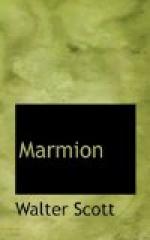Stanza xxiv. line 704. St. Withold, St. Vitalis. Cp. King Lear, iii. 4. III. Clarendon Press ed., and note. This saint was invoked in nightmare.
Stanza xxv. line 717. Malison, curse.
line 717. ’The Cross of Edinburgh was an ancient and curious structure. The lower part was an octagonal tower, sixteen feet in diameter, and about fifteen feet high. At each angle there was a pillar, and between them an arch, of the Grecian shape. Above these was a projecting battlement, with a turret at each corner, and medallions, of rude but curious workmanship, between them. Above this rose the proper Cross, a column of one stone, upwards of twenty feet high, surmounted with a unicorn. This pillar is preserved in the grounds of the property of Drum, near Edinburgh. The Magistrates of Edinburgh, in 1756, with consent of the Lords of Session, (proh pudor!) destroyed this curious monument, under a wanton pretext that it encumbered the street; while, on the one hand, they left an ugly mass called the Luckenbooths, and, on the other, an awkward, long, and low guard-house, which were fifty times more encumbrance than the venerable and inoffensive Cross.
’From the tower of the Cross, so long as it remained, the heralds published the acts of Parliament; and its site, marked by radii, diverging from a stone centre, in the High Street, is still the place where proclamations are made.’—Scott.
See Fergusson’s ‘Plainstanes,’ Poems, p. 48. The Cross was restored by Mr. Gladstone in 1885, to commemorate his connexion with Midlothian as its parliamentary representative.
line 735. ’This supernatural citation is mentioned by all our Scottish historians. It was, probably, like the apparition at Linlithgow, an attempt, by those averse to the war, to impose upon the superstitious temper of James iv. The following account from Pitscottie is characteristically minute, and furnishes, besides, some curious particulars of the equipment of the army of James iv. I need only add to it, that Plotcock, or Plutock, is no other than Pluto. The Christians of the middle ages by no means disbelieved in the existence of the heathen deities; they only considered them as devils, and Plotcock, so far from implying any thing fabulous, was a synonyme of the grand enemy of mankind.” {2} “Yet all thir warnings, and uncouth tidings, nor no good counsel, might stop the King, at this present, from his vain purpose, and wicked enterprize, but hasted him fast to Edinburgh, and there to make his provision and famishing, in having forth of his army against the day appointed, that they should meet in the Barrow-muir of Edinburgh: That is to say, seven cannons that he had forth of the Castle of Edinburgh, which were called the Seven Sisters, casten by Robert Borthwick, the master-gunner, with other small artillery, bullet, powder, and all manner of order, as the master-gunner could devise.




